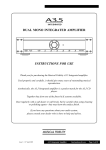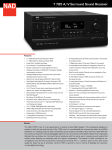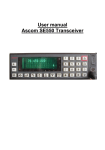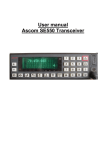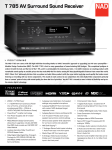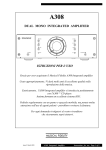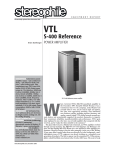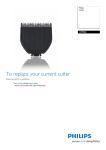Download NAD Electronics t765 User's Manual
Transcript
T 765 A/V Surround Sound Receiver Features • • • • • • • • • • • • • • • • • • • 7 x 80W Simultaneous Full Disclosure Power 7 x 100W Minimum Continuous Power (FTC) PowerDrive™ amplifier technology Holmgren™ Toroidal Power Supply Modular construction for simple upgrade and service Audyssey Auto Setup and Calibration of all speaker settings using supplied microphone Data Port for use with optional NAD IPD 1 Dock for iPod® Dolby Digital, Dolby Digital EX, ProLogic II, ProLogic IIx, DTS, DTS ES, DTS 24/96, DTS NEO:6, EARS and Stereo Enhanced Surround Modes 5 A/V Custom Presets store unique listening modes, DSP options, tone, speaker and display settings Direct speaker level adjustment for surround, center and sub NAD Soft Clipping™ Burr-Brown 24 bit 96kHz A/D converter Burr-Brown 24 bit 192kHz Stereo D/A converters (x5) Texas Instruments Aureus™ 7.1 DSP (32 bit dual core floating point design) 3 1080p HDMI Video Inputs switch to 1 Output, freely assignable Cross Conversion of all analog video formats 7 Analog Stereo Audio Inputs (1 front panel) Media Player MP front panel input 6 Analog Video Inputs, all S-Video and Composite (1 front panel), 3 Component Video • 7 Digital Audio Inputs, 3 Coax and 4 Optical (1 front panel) • 3 Analog Stereo Audio Outputs, 2 assignable as Tape Out, or as Zone 3 and Zone 4 Outputs with independent source and volume control • Back Surround Amplifier Channels can be reassigned for Zone 2 or front Bi-Amp • 3 Video Monitor Outputs, Component, S-Video and Composite formats • 3 Analog Video Outputs, 2 Tape (Composite and S-Video) and 1 Zone (Composite) • 2 Digital Outputs, 1 Coaxial, 1 TOSLINK • 7.1 Analog Input (for DVD Audio/SACD/ETC.) • Speaker A + B switching (Speakers B stereo only) • Zone 2 A/V Line Level Output with independent source and volume selection • ZR-4 Second Zone Remote included with discrete codes for independent zone • IR Input • 3 x IR Outputs • RS-232 port interface for advanced control systems • 3 x 12V Output Triggers, 1 x 12V input • Preamp Outputs for all 7.2 channels (2 Subwoofers) • RDS FM/AM Tuner with 30 direct access presets • XM Ready – XM subscription and optional XM module required • HTR-3 Illuminated Learning Remote Control Details The NAD T765 is heir to many generations of award winning NAD designs. This exceptional pedigree is evident in both the look and the feel of the T765, and it is unmistakable the moment you listen. It is NAD’s insistence on creating products with remarkable sound quality at sensible prices that has made NAD the first choice among the most knowledgeable listeners from around the world. NAD’s “Music First” philosophy dictates that we endow our Surround Sound products with the same warm involving sound quality that makes music listening so rewarding with our stereo components. This stands in stark contrast to our competitors who view Surround Sound components primarily from a “content” point of view, with sound quality far down the list of priorities. Yet the T765 is second to none in terms of flexibility and up-to-the-minute digital technology. Full Disclosure Power Ratings Inflated power specifications have been used to “sell” receivers as long as there have been receivers to sell. But not at NAD. Instead, we encourage our customers take a clear-eyed look at the real issues. Receivers don’t make music and filmsound by driving laboratory test-loads, they do it by driving loudspeakers. And loudspeakers, whether labeled 8Ω or 4Ω in “nominal impedance,” are far more challenging. A speaker that “looks like” an 8Ω resistor at some frequencies will show 4Ω at others, and often, 3Ω or even 2Ω at still others. Furthermore, actual loudspeaker loads are far more complex than simple test resistors. What does all this mean? Simply, that power on paper is but a poor predictor of “how loud,” “how dynamic,” “how musical.” Nevertheless, in a competitive market comparisons will be made. But when you make them, read the fine print—all of it. At NAD we test under the most demanding, “worst-case” conditions, reporting the minimum power output we achieve at any frequency within human audibility (full audible bandwidth of 20Hz-20kHz), and with all channels driven and fully stressed simultaneously at clearly specified, vanishingly low distortion. Many competitors do not: they often quote single-frequency power (1 kHz) reflecting at most one “associated channel” (maximum 2 channels) dominating the receiver’s power supply—often under a variety of deceptive power headings. And if distortion is stated at all it’s usually at quite high levels: 0.5 percent, 1 percent—in one case, 10 percent!—it’s easy to print big numbers that simply do not tell the true story. The bottom line: don’t be fooled by specs; let your ears be the judge. PowerDrive™ This keystone of the NAD receivers’ amp-section design underpins the unique dynamic potential of every model. PowerDrive’s foundation is a “dual-rail” power supply that delivers optimized internal voltage levels especially during the most demanding conditions: dynamic peaks, big musical transients, deep-bass excursions that drive a loudspeaker into its most power-hungry impedance range. It’s a little like the “kickdown” of a sophisticated automatic transmission - providing distortion-free current on demand. PowerDrive is one big reason why NAD AV receivers do not exhibit the dynamic compression, flattened imaging, and even tinges of harshness audiophiles so often decry as “receiver sound.” And PowerDrive not only makes NAD receivers sound better, it makes them cooler running, more efficient, and more reliable as well. Performance Today’s advanced Surround Sound receivers require quality in the digital decoding stages, the video processing section, and in the power amplifier design for the best overall performance. The T765 is an excellent example of the NAD Design Team’s expertise in all three areas. Not only that, but we have made many ergonomic refinements to simplify operation and make it more enjoyable to get all the performance this magnificent receiver is capable of delivering. Using the latest 32 bit Dual Core Floating Point DSP technology, NAD was able to include the expected surround formats from Dolby and DTS, as well as including NAD’s own highly regarded music surround mode; EARS. Unlike, the typical artificially enhanced DSP modes like “Club”, “Stadium”, and “Church”, EARS uses DSP technology to extract the natural ambience of the recording. This is redirected to the surround channels to create natural surround sound from any 2 channel source. This induces a warm natural reverberant effect without the artificial “BOING” of artificial reverb. The surround mode of the source material is automatically detected via the digital inputs of the T765, and the “highest” or most advanced form of decoding is switched in. Conversion of the encoded digital bitstream is performed with high resolution and extremely linear Burr-Brown 24 bit/192kHz D/A Converters carefully selected for their performance capabilities. The T765 uses five two-channel DACs rather than the usual single 8 channel DAC favored by many of today’s surround sound receivers. We have found that the sonic performance of the two-channel DACs used in a dual differential mode, is well worth the extra cost of this configuration. NAD’s reputation for producing power amplifiers that are both potent and musical is upheld in fine manner with the T765. Boasting a minimum of 80 watts continuous power per channel, the T765 can easily fill a room with lifelike sound levels. Credit for the sound of NAD’s components rests squarely with our unique design approach and our experienced and very talented design team. Most companies design their products to a technical specification and a price point. While this sounds logical enough, it does not address the way the product will actually be used by the eventual owner. You don’t listen to specifications, you listen to music and sound. While NAD products exhibit excellent technical measurements, we have relied on our own ears and listening experience to determine the final design of our products. Because of our unique design approach, NAD’s sound is simply more “real” sounding, adding enjoyment and excitement to your favourite films and music recordings. Flexibility The T765 has all the flexibility required to serve as the command center for even the most sophisticated Home Theater and multiroom systems. A full suite of video switching caters to all the popular video formats (HDMI, Component Video, S-Video, and Composite Video). Digital inputs (including a handy front panel input) and outputs are available in both coaxial and optical formats to make it easy to attach all your digital sources for playback and recording. With the T765, NAD has made it easy to add more speakers for listening to music in an additional room or “zone”. A second pair of speakers can simply be added to the front channel amplifiers and switched on or off from the remote control or front panel switch. More elaborate systems can also be created using the Zone 2, 3 and 4 outputs to add additional amplifiers and speakers with the added benefit of independent source selection and volume control. For added flexibility the back surround amplifier channels can be assigned to Zone 2 if the main zone is 5.1. A separate second zone remote is included. There are also 12 volt triggers to automatically switch remote zone amplifiers on and off, and even an RS-232 data port for connection to highly advanced automated control systems. Thoughtful features like discrete On and Off codes, direct access to inputs and FM station presets facilitate the integration of the T765 into elaborate remote control systems. An analog 7.1 input is also provided for attaching a DVD-Audio T 765 Surround Sound A/V Receiver player or any other yet to be developed surround decoder, making sure the T765 does not become obsolete anytime soon. Preamp outputs allow the addition of more powerful amplifier channels. The T765 includes a data port specifically designed to control an iPod with the addition of NAD’s optional IPD-1 Dock. This allows the iPod’s meta-data to be displayed on the OSD and be controlled using the NAD remote control. Audio and Video connections and iPod recharging are also featured in the iPod Dock. All input circuitry is contained on 5 easily removable plug in cards. Although this construction technique is more costly to implement, it offers several important advantages. 1) Speed to market for new technology. 2) Upgrade for older units 3) Simple field service. Luxurious Simplicity All the capability and flexibility in the world is quite useless if the receiver becomes too complicated to be operated by every member of the family. NAD has taken special measures to make operation of the T765 as logical and straightforward as possible. Initial system setup is best accomplished using your television monitor and the clear and simple On Screen Display (OSD), which can be configured to also give status updates as settings are changed in everyday use. Once the T765 is informed of your specific system set-up, all settings are stored in a non-volatile memory making this a one time task. The informative front panel display indicates complete information about the source being listened to or watched including selected surround mode and volume setting. The front panel display can be easily customized by renaming inputs and even determining what information you prefer to have displayed and when to display it. Automatic Audio Setup is available using the supplied calibrated microphone. Simply place the microphone in the listening position and select Audyssey auto-calibration and the system automatically detects which speaker is connected, chooses the ideal crossover point to the subwoofer, checks speaker phasing, and adjusts the levels and delays. These adjustments are made to a level of accuracy that it would be difficult to duplicate by ear alone. The tuner includes 40 favorite station presets in any mix of AM or FM stations. FM stations that don’t automatically display their name in addition to their broadcast frequency (RDS function), can instead be given a custom name. We also include a “Digital Broadcast Ready” socket on the rear panel for adding an outboard XM module. All the control software is included, just plug in the module and start enjoying the clear sound and expansive content selection available with Digital Radio Broadcast. Five independent “Audio Video Custom Presets” can store unique listening modes, DSP options, tone, speakers and display settings for instant recall, making it easy to custom tailor your system for different types of program material. Encoded surround modes like Dolby Digital and DTS are automatically selected if the program is so encoded. The T765 also remembers your last used settings when switched in and out of Standby mode. The included HTR 3 remote handset is itself an engineering tour-deforce. Able to control up to 8 different components, the device key illuminates to clearly shows what device is being controlled. It has illuminated buttons for easy operation in low light environments, and the length of time the illumination is on can easily be adjusted. Remote commands for products not already included in the HTR 3’s memory can be easily “taught” to the HTR 3. And the HTR 3’s Macro function allows up to 64 individual commands to be triggered by the pressing just two keys. With this feature, all of the commands required for watching a DVD, for example, are executed automatically by the HTR 3’s Macro function. Summary The T765 offers remarkable performance and flexibility in a compact and simple to operate package. This multi-channel powerhouse will bring your favorite music and movies to life in your home entertainment room with an absolute minimum of fuss and a maximum of pure enjoyment. SPECIFICATIONS Amplifier Section Simultaneous Full Disclosure Power 7 x 80W (19dBW) Minimum Continuous Power (FTC) Power Output Stereo Mode (8 Ohms within rated distortion) Harmonic Distortion; FM Mono 0.25% Harmonic Distortion; FM Stereo 0.5% 7 x 100W (20dbW) Signal/noise; Mono 60dB 100W (20dbW) Signal/noise; Stereo 55dB (4/8 Ohms, 20Hz - 20kHz, at rated distortion) Stereo separation at 1kHz IHF dynamic power; 8 Ohms 2 x 160W (22dBW) IHF dynamic power; 4 Ohms 2 x 270W (24.3dBW) IHF dynamic power; 2 Ohms 2 x 300W (24.8dBW) Frequency response; + 1.5dB XM Ready 40dB 30Hz - 15kHz Yes Total harmonic distortion at rated power 0.05% Video Section IM distortion at rated power 0.05% Input and output impedance 75 Ohms 60 Component Video Bandwidth 50MHz Damping factor 8 Ohms Input sensitivity and impedance Frequency response 200mV / 50k Ohms 5 to 20,000 Hz Signal/noise ratio; ref rated power 8 Ohms >100dB Signal/noise ratio; ref 1W / 8 Ohms >90dB Remote Controls ±0.8dB HTR-3 (main) / ZR-4 (2nd zone) HDMI – Video Yes Physical Specifications Net Dimensions (W x H x D) 17 1/8 x 6 1/8 x 15” (435 x 155 x 382mm) Gross Dimensions (W x H x D)* Tuner Section 17 1/8 x 6 5/8 x 16 9/16” (435 x 168 x 420mm) Input sensitivity Mono 16.1dBf Net Weight 38 lbs (17.26kg) 50dB Stereo: 36.1dBf Shipping Weight 41 lbs (18.60kg) * Gross dimensions include: Volume knob / speaker terminals / connectors / feet. Note: Installers should allow a minimum clearance of 2-4 inches for wire management. NAD Electronics International reserves the right to change specifications or features without notice. NAD is a registered trademark of NAD Electronics International. All rights reserved. No part of this publication may be reproduced, stored, or transmitted in any form whatsoever without the written permission of NAD Electronics International. © 08/07 NAD Electronics International. rev1. www.NADelectronics.com




